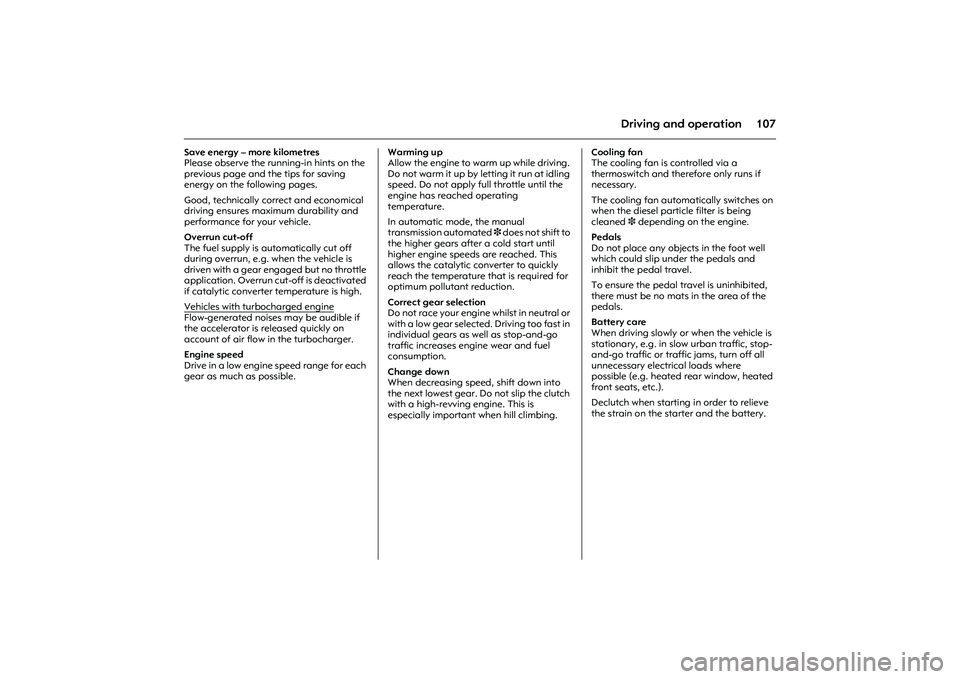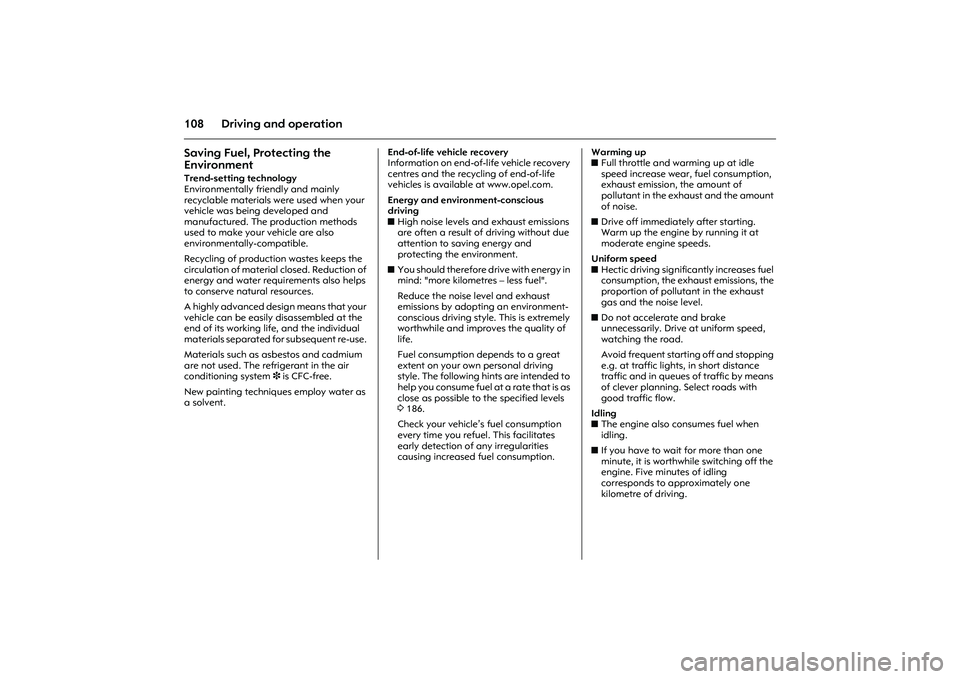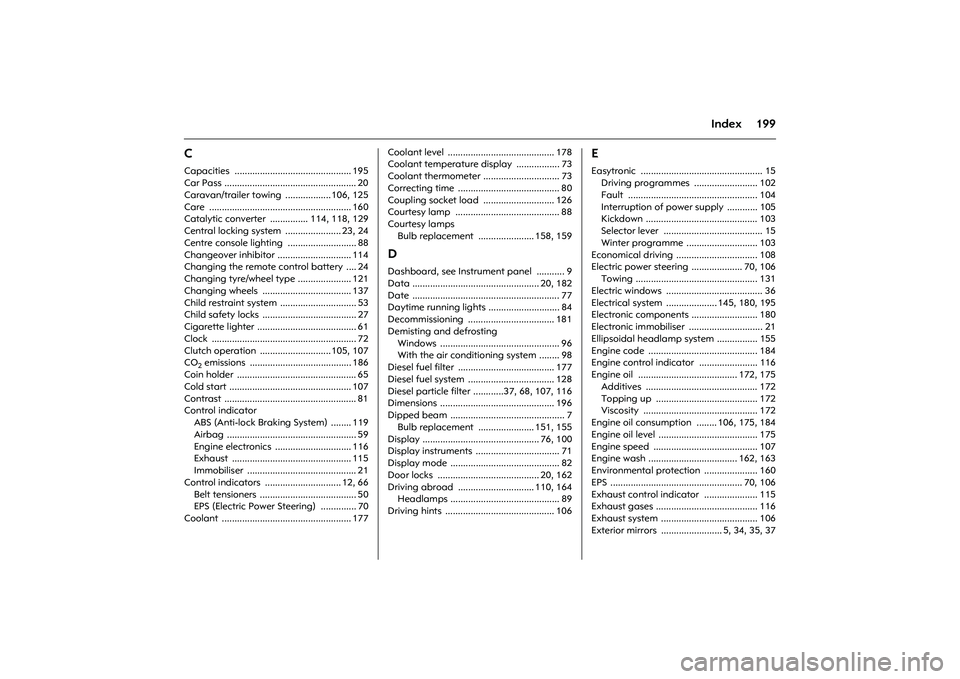ECO mode OPEL COMBO 2010 User Guide
[x] Cancel search | Manufacturer: OPEL, Model Year: 2010, Model line: COMBO, Model: OPEL COMBO 2010Pages: 212, PDF Size: 2.49 MB
Page 113 of 212

107
Driving and operation
Save energy – more kilometres
Please observe the running-in hints on the
previous page and the tips for saving
energy on the following pages.
Good, technically correct and economical
driving ensures maximum durability and
performance for your vehicle.
Overrun cut-off
The fuel supply is automatically cut off
during overrun, e.g. when the vehicle is
driven with a gear engaged but no throttle
application. Overrun cut-off is deactivated
if catalytic converter temperature is high.
Vehicles with turbocharged engine
Flow-generated noises may be audible if
the accelerator is released quickly on
account of air flow in the turbocharger.
Engine speed
Drive in a low engine speed range for each
gear as much as possible. Warming up
Allow the engine to warm up while driving.
Do not warm it up by letting it run at idling
speed. Do not apply full throttle until the
engine has reached operating
temperature.
In automatic mode, the manual
transmission automated 3 does not shift to
the higher gears after a cold start until
higher engine speeds are reached. This
allows the catalytic converter to quickly
reach the temperature that is required for
optimum pollutant reduction.
Correct gear selection
Do not race your engine whilst in neutral or
with a low gear selected. Driving too fast in
individual gears as well as stop-and-go
traffic increases engine wear and fuel
consumption.
Change down
When decreasing speed, shift down into
the next lowest gear. Do not slip the clutch
with a high-revving engine. This is
especially important when hill climbing. Cooling fan
The cooling fan is controlled via a
thermoswitch and therefore only runs if
necessary.
The cooling fan automatically switches on
when the diesel particle filter is being
cleaned 3 depending on the engine.
Pedals
Do not place any objects in the foot well
which could slip under the pedals and
inhibit the pedal travel.
To ensure the pedal travel is uninhibited,
there must be no mats in the area of the
pedals.
Battery care
When driving slowly or when the vehicle is
stationary, e.g. in slow urban traffic, stop-
and-go traffic or traffic jams, turn off all
unnecessary electrical loads where
possible (e.g. heated rear window, heated
front seats, etc.).
Declutch when starting in order to relieve
the strain on the starter and the battery.
Page 114 of 212

108 Driving and operationSaving Fuel, Protecting the
Environment Trend-setting technology
Environmentally friendly and mainly
recyclable materials were used when your
vehicle was being developed and
manufactured. The production methods
used to make your vehicle are also
environmentally-compatible.
Recycling of production wastes keeps the
circulation of material closed. Reduction of
energy and water requirements also helps
to conserve natural resources.
A highly advanced design means that your
vehicle can be easily disassembled at the
end of its working life, and the individual
materials separated for subsequent re-use.
Materials such as asbestos and cadmium
are not used. The refrigerant in the air
conditioning system 3 is CFC-free.
New painting techniques employ water as
a solvent. End-of-life vehicle recovery
Information on end-of-life vehicle recovery
centres and the recycling of end-of-life
vehicles is available at www.opel.com.
Energy and environment-conscious
driving
zHigh noise levels and exhaust emissions
are often a result of driving without due
attention to saving energy and
protecting the environment.
zYou should therefore drive with energy in
mind: "more kilometres – less fuel".
Reduce the noise level and exhaust
emissions by adopting an environment-
conscious driving style. This is extremely
worthwhile and improves the quality of
life.
Fuel consumption depends to a great
extent on your own personal driving
style. The following hints are intended to
help you consume fuel at a rate that is as
close as possible to the specified levels
3186.
Check your vehicle’s fuel consumption
every time you refuel. This facilitates
early detection of any irregularities
causing increased fuel consumption. Warming up
zFull throttle and warming up at idle
speed increase wear, fuel consumption,
exhaust emission, the amount of
pollutant in the exhaust and the amount
of noise.
zDrive off immediately after starting.
Warm up the engine by running it at
moderate engine speeds.
Uniform speed
zHectic driving significantly increases fuel
consumption, the exhaust emissions, the
proportion of pollutant in the exhaust
gas and the noise level.
zDo not accelerate and brake
unnecessarily. Drive at uniform speed,
watching the road.
Avoid frequent starting off and stopping
e.g. at traffic lights, in short distance
traffic and in queues of traffic by means
of clever planning. Select roads with
good traffic flow.
Idling
zThe engine also consumes fuel when
idling.
zIf you have to wait for more than one
minute, it is worthwhile switching off the
engine. Five minutes of idling
corresponds to approximately one
kilometre of driving.
Page 205 of 212

199
Index
CCapacities .............................................. 195
Car Pass .................................................... 20
Caravan/trailer towing .................. 106, 125
Care ........................................................ 160
Catalytic converter ............... 114, 118, 129
Central locking system ...................... 23, 24
Centre console lighting ........................... 88
Changeover inhibitor ............................. 114
Changing the remote control battery .... 24
Changing tyre/wheel type ..................... 121
Changing wheels ................................... 137
Child restraint system .............................. 53
Child safety locks ..................................... 27
Cigarette lighter ....................................... 61
Clock ......................................................... 72
Clutch operation ............................ 105, 107
CO
2 emissions ........................................ 186
Coin holder ............................................... 65
Cold start ................................................ 107
Contrast .................................................... 81
Control indicator
ABS (Anti-lock Braking System) ........ 119
Airbag ................................................... 59
Engine electronics .............................. 116
Exhaust ............................................... 115
Immobiliser ........................................... 21
Control indicators .............................. 12, 66
Belt tensioners ...................................... 50
EPS (Electric Power Steering) .............. 70
Coolant ................................................... 177Coolant level .......................................... 178
Coolant temperature display ................. 73
Coolant thermometer .............................. 73
Correcting time ........................................ 80
Coupling socket load ............................ 126
Courtesy lamp ......................................... 88
Courtesy lamps
Bulb replacement ...................... 158, 159
DDashboard, see Instrument panel ........... 9
Data .................................................. 20, 182
Date .......................................................... 77
Daytime running lights ............................ 84
Decommissioning .................................. 181
Demisting and defrosting
Windows ............................................... 96
With the air conditioning system ........ 98
Diesel fuel filter ...................................... 177
Diesel fuel system .................................. 128
Diesel particle filter ............37, 68, 107, 116
Dimensions ............................................. 196
Dipped beam ............................................. 7
Bulb replacement ...................... 151, 155
Display .............................................. 76, 100
Display instruments ................................. 71
Display mode ........................................... 82
Door locks ........................................ 20, 162
Driving abroad .............................. 110, 164
Headlamps ........................................... 89
Driving hints ........................................... 106
EEasytronic ................................................ 15
Driving programmes ......................... 102
Fault ................................................... 104
Interruption of power supply ............ 105
Kickdown ............................................ 103
Selector lever ....................................... 15
Winter programme ............................ 103
Economical driving ................................ 108
Electric power steering .................... 70, 106
Towing ................................................ 131
Electric windows ...................................... 36
Electrical system .................... 145, 180, 195
Electronic components .......................... 180
Electronic immobiliser ............................. 21
Ellipsoidal headlamp system ................ 155
Engine code ........................................... 184
Engine control indicator ....................... 116
Engine oil ....................................... 172, 175
Additives ............................................ 172
Topping up ........................................ 172
Viscosity ............................................. 172
Engine oil consumption ........ 106, 175, 184
Engine oil level ....................................... 175
Engine speed ......................................... 107
Engine wash ................................... 162, 163
Environmental protection ..................... 160
EPS .................................................... 70, 106
Exhaust control indicator ..................... 115
Exhaust gases ........................................ 116
Exhaust system ...................................... 106
Exterior mirrors ........................ 5, 34, 35, 37